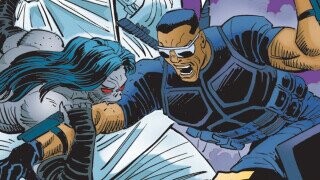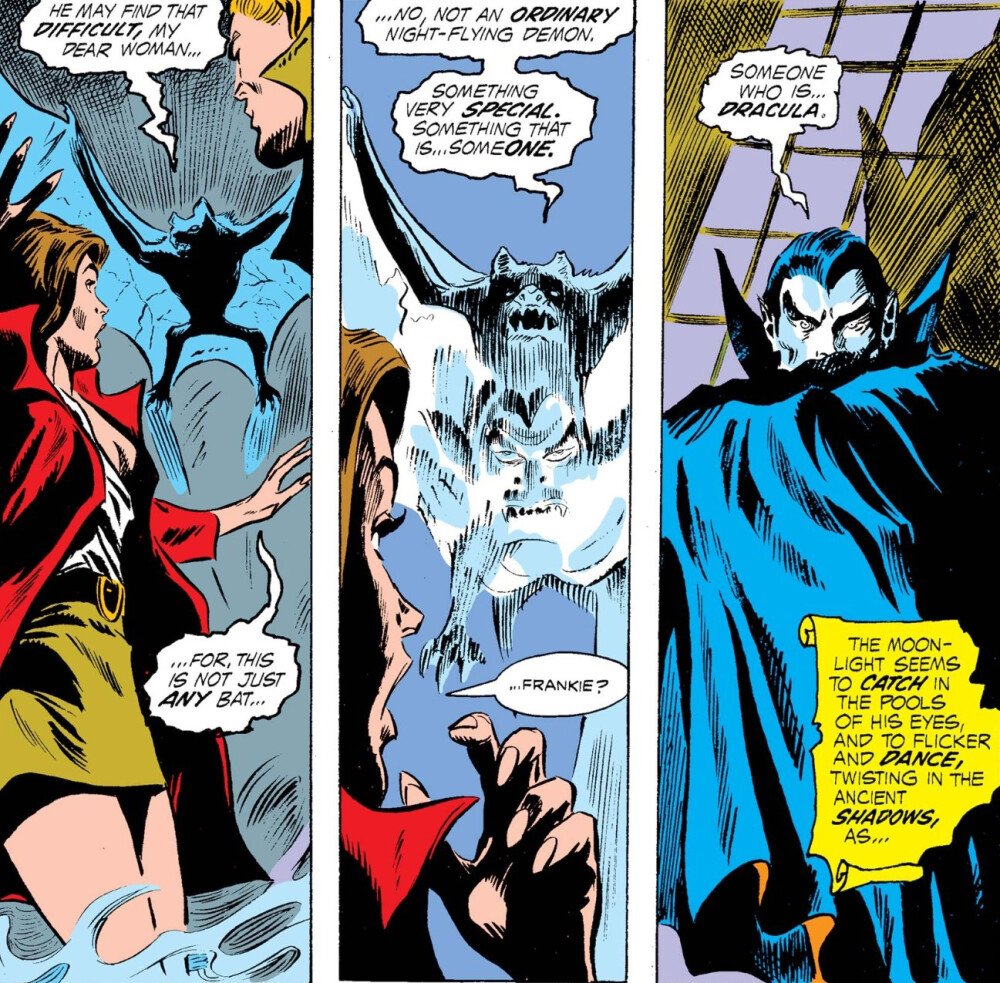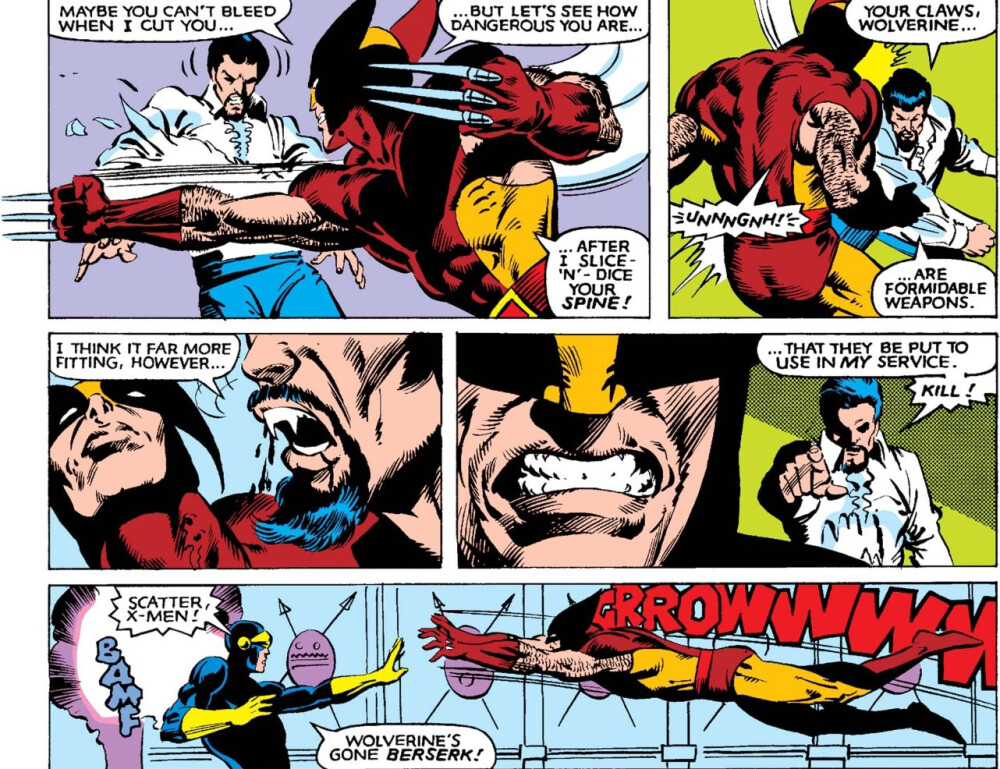Marvel's Bizarre History With Vampires

While some comic book trends are insane products of their era, other trends are timeless, waxing, and waning as the years pass. With Sony's Morbius threatening to inflict Jared Leto on the world later this year, let's trace a trend that has persisted at different levels of intensity throughout Marvel's history: vampires ...
Vampires Fight Your Favorite Heroes (In Name Only)
The first appearance of a vampire in a Marvel Comic can be found in 1942's Marvel Mystery Comics 35. The anthology title featured the greatest heroes of the company's shared universe: Sub-Mariner, Human Torch (This one, not the one you care about), The Patriot (This one, not the one The Falcon and the Winter Soldier wants you to care about), The Vision (a significantly less interesting character than the one who has a solid sweater game), Jimmy Jupiter (Who?), and Terry Vance (The School Boy Sleuth, which just makes me wish this were a comic about ScHoolboy Q instead.)
Don't Miss
In "The Banquet of Blood!" by Alex Blum, the Angel tangles with the undead. I found it disappointing that the story deals with this guy and not (dare I say) the greatest original X-Man. The Angel of the 1940s was detective Tom Halloway. Tommy compensates for his lack of superpowers with a serious case of Cape Envy that causes him to dress up like a costumed adventurer. When he attempts to free a girl from a vampire attack, the vampire captures him and brings him to a castle. In a scene not too far from Madonna's "Justify My Love" video, the vampire drags Angel through his castle's halls and throws the hero into a room full of shirtless dudes chained to pillars. Our protagonist eventually frees the scantily clad captives. They assist him in finding and burning the vampire's casket, ending the supernatural threat.

Marvel
Completely unrelated to this lackluster debut, vampires would become rare in comics during the following decades. In 1954, the Senate Judiciary Committee's Subcommittee to Investigate Juvenile Delinquency turned its attention toward the comics industry, portraying comic books as the cause of moral rot in the youth. The industry, fearing the heavy hand of government censorship, created the Comics Code Authority as a self-regulating body, putting limits on their content before outsiders could do so. One tenet of the code is particularly relevant: "Scenes dealing with, or instruments associated with, walking dead, torture, vampires and vampirism, ghouls, cannibalism, and werewolfism are prohibited." Besides inspiring me to answer "Werewolfism" the next time someone asks my religion, this prohibition also effectively shuttered the booming horror comics industry of the time. Supernatural creatures would be scarce in comics until Marvel embraced …
The Living Vampire As A Workaround
While the Comics Code Authority stamp on a cover was critical to securing distribution in the CCA's early days, Marvel successfully published a cautionary tale about the use of hallucinogens in Amazing Spider-Man 96-98 without the stamp on the cover. Mere issues after the drug storyline broke new ground, writer Roy Thomas and artist Gil Kane introduced a CCA-safe vampire in "living vampire" Morbius. Morbius looks like the popular conception of nosferatu: pale white face, pig nose, red eyes, and an Elvis-like jumpsuit. However, the fact that his vampirism comes from science and not magic inexplicably makes him acceptable to the CCA. In case the reader doesn't understand that Morbius is different from your average bloodsucker, Thomas makes sure to clarify with this bit of dialogue from Morbius, "Vampire? Yes–I suppose your tiny mind would label me thus. But what do simple names–empty epithets–mean to me? I am more than any name–beyond mere epithet." He's not a vampire, and–if you think he is–it's clearly because you're dumb.
Amazing Spider-Man 101–Morbius's debut issue–focuses on Peter Parker's attempts to cure himself after ingesting a formula that makes him grow four extra arms. While staying at the home of Dr. Curt Connors, a.k.a. The Lizard, Peter comes into conflict with Morbius. In issue 102, we learn that Dr. Michael Morbius is a Nobel winner, though we never find out which prize; that's a shame since it would be hilarious if he turned out to be an accomplished peace activist as well as a vampi– I mean, "living vampire." He becomes a creature of the night when pursuing bat-based solutions for a rare disease dissolving his blood cells. Kane fills the issue with lots of psychedelic art before Thomas delivers a convenient ending where an enzyme in Morbius' blood can reverse Peter's condition. During the final battle, Morbius disappears in the undertow of the Long Island Sound.

Marvel
Emboldened by this newfound means of incorporating vampires into the Marvel Universe, the House of Ideas decided to go all the way by …
Ripping Off Bram Stoker
When the introduction of a pseudo-vampire failed to bring the comics industry to ruin, Marvel introduced the real thing into its mythology. Tomb of Dracula was initially intended as a black & white magazine, but–due to the failure of similar Marvel magazines like Savage Tales–it debuted as a color comic book series in 1972.

Marvel
Dracula rarely appears in the comic; the narrative focuses more on Dracula's descendant Frank Drake and his relationship with other vampire hunters. When Dracula does appear, though, artist Gene Colan's impressionistic style makes for a vampire king whose incorporeal form is constantly bleeding into the shadows. In a fine bit of nightmare fuel, the artist is particularly skilled at drawing bat-to-Dracula transformations featuring the faint outline of Dracula's face on a giant bat's torso. Tomb of Dracula is a classic because it is a great match of a beloved character and an artist whose inky pages perfectly set an atmosphere of dread.

Marvel
The character was such a success that Marvel was finally able to realize its ambition of a black & white Dracula magazine with 1973's Dracula Lives!. Comics in magazine format benefited from skirting the CCA's stranglehold on distribution, allowing creators to create adult stories for older audiences. Dracula Lives! 1 takes full advantage of this freedom with a centerpiece story following Dracula after he drinks the blood of a heroin addict on the streets of contemporary New York City. As he is gripped with the pains of withdrawal, Dracula preys on other addicts and gets mixed up with a cult. The rest of the first issue features new stories, reprints, and film stills of Bela Lugosi and Christopher Lee as the title character, making the publication more of a Dracula fanzine than a comic book. This is the one must-read title of all the Marvel vampire comics if you can get your hands on it.

Marvel
Ice Skating Uphill, Or “The Often-Confusing Evolution Of Blade”
As a comic lover in 2022 reading through Blade's almost 50 years of history, I have to admit that the experience of following the character's evolution was a bit of a head-scratcher. After his introduction in Tomb of Dracula 10, we learn in issue 13 that a vampire who might be Dracula killed Blade's mother as he was being born. As the series continues, we learn that Blade is immune to vampirism, which is weird since the Blade that I know and love was born half-vampire.
I was surprised to learn that Blade was basically a normal human for the first 25 years of his existence. The black and white magazine Vampire Tales introduced the idea that Blade's mother was a sex worker and he was raised in a brothel after her death, with the character's origin unchanged until the 1994 animated series. This was a superhero TV show that went out of its way to avoid showing its superheroes throwing punches, so it makes sense that the creators might want to avoid the risqué origin of Vampire Tales. To compensate, Blade was introduced as half-vampire for the first time, a change embraced in the 1998 film.

Marvel
With the non-comics-reading public exposed to two instances of Blade as a vampire/human hybrid, Marvel went through a convoluted process of introducing this origin in the comics. 1999's Peter Parker: Spider-Man 7 and 8 feature a team-up between Spider-man and Blade. In a throw-away panel near the end of the story, our old friend Morbius bites Blade. The nibble isn't addressed until the 1999-2000 Blade: Vampire Hunter series, where the bite (which–again–was barely acknowledged when it happened) is discussed as turning Blade into a vampire. I would be mad at how poorly executed this whole retcon is, but I'm glad for anything that allows me to better imagine Wesley Snipes hanging out with Spider-Man.
Fall Of The Vampires, Rise Of The Midnight Sons
By the early '80s, the success of Tomb of Dracula and its various spinoff series caused a glut of bloodsuckers. One need look no further than 1975's Hellcow to realize that Marvel went a little vampire-crazy in the previous decade. To remedy this excess, the 1983 Dr. Strange storyline "The Montesi Formula" eliminated all vampires from the Marvel Universe.

Marvel
Vampires became a rare sight in Marvel Comics for almost a decade, but many of Marvel's vampire characters resurfaced in the early '90s. The Rise of the Midnight Sons event was meant to piggyback on the popularity of the revamped Ghost Rider title by launching several new first issues: the additional Ghost Rider book Spirits of Vengeance, Darkhold, Morbius the Living Vampire, and Nightstalkers. In this story, Lilith (the "Demon Mother" and not Dracula's daughter of the same name) plans to raise an army of monsters while spending an unusual amount of time at '90s NYC hotspot Limelight. A group of heroes is prophesied to defeat her, and–in big, dumb comic book crossover tradition–we watch them gather and face her across six issues.
Nightstalkers is the bright spot of this crossover. Writer D.G. Chichester and artist Ron Garney tell a story of what vampire hunters do when there are no vampires to hunt. Without his typical nemeses to fight and suffering from stunted social skills, Blade is confined to an asylum. Former vampire Hannibal King still craves blood even though it's not necessary for his survival. Frank Drake continues his streak of being the blandest vampire hunter by being married and having a kid. Lilith's machinations get them back together.
My notes on the Nightstalkers in Rise of the Midnight Sons contain the word "badass" no less than five times, and I stand by that assertion. Blade fights two Ghost Riders without breaking a sweat. Frank Drake gets considerably less lame when he creates an arsenal that includes a gigantic gun called "Linda" ("...you know, 'The Exorcist!'") In the most awesome moment of the entire crossover, the Nightstalkers turn on all of the other assembled heroes the moment Lilith is defeated. As the most pressing evil is eliminated, Hannibal declares, "Ghost Rider and Morbius are the next piece of business on our list." Blade adds, "And this saves us the hassle of tracking them down," shortly before Dr. Strange teleports the trio away. The Nightstalkers are so dedicated to fighting the supernatural that they can turn from camaraderie to hostility at the drop of a hat. I wish I was as dedicated to anything as they are to killing monsters.

Marvel
Nightstalkers would continue for 18 issues, wrapping with a storyline that revived Dracula after a decade of being dead. Surprisingly, Dracula's stories since his return have primarily played out in the mutant corner of the Marvel Universe since …
The X-Men Have A Really Weird Ongoing Relationship With Dracula
For the first 20 years of their existence, the X-Men's world was vampire-free, unless you count Sauron's weird "I'm an Energy Vampire but I'm also a Pterodactyl Man" gimmick. Chris Claremont changed that by bringing Dracula into their lives. Despite the fact that he's worked with some of the best artists in comics (John Byrne, John Romita Jr., Dave Cockrum), Claremont's writing style on X-Men is so verbose that his creative partners' beautiful compositions are often fighting for space with word balloons. It makes sense that–with his love of elaborate prose–Claremont is so drawn to a gothic literary character.
In 1982's Uncanny X-Men 159, Dracula possesses Storm and provokes a fight with the X-Men that's expertly drawn by Cockrum. It ends with Dracula yielding and teasing a future meeting "in a time and place of my choosing." The rematch comes months later in X-Men Annual 6. The culmination of this issue is a fight featuring an all-time great in speculative nerd match-ups. As Dracula fights the X-Men, he has a particularly brutal tangle–boasting clean and crisp art from the genius Bill Sienkiewicz–with Wolverine that ends with him taking possession of the X-Man. The X-Men defeat Dracula with an assist from his daughter, but the Prince of Darkness would go on to be a recurring X-foe in the decades to follow.

Marvel
Like most things related to the X-Men, the team's relationship with Dracula sucks without Claremont. 2006's Apocalypse vs. Dracula started as a potentially earth-shattering clash between two immortal schemers but became the type of continuity wank that Claremont and no one else does well. Likewise, the 2010 storyline Curse of the Mutants continues the post-Claremont malaise of mutants and vampires joining together for stories that are somehow less than the sum of their parts; when they bother to remember it at all, most fans know this story as "The One Where Jubilee Becomes a Vampire." Most recently, the X-Men/Dracula arc continued into the Wolverine solo book, but we don't need to pay attention to that because the Hickman era of X-Men is just Grant Morrison's New X-Men dumbed down and stretched across 10 titles a month.
In the new millennium, Marvel tried to cash in on the vampire mania spurred by Twilight with books featuring Blade and Morbius. However, these series never lasted beyond 12 issues. Marvel should take advantage of its complete destruction of the Comics Code Authority as well as the recent horror comics boom (Walking Dead, Red Room, Afterlife with Archie, and even Marvel's own Immortal Hulk) to give free rein to talent dedicated to innovative horror storytelling. This plan could always end up failing, but at least it would be a more dignified failure than forever having Jared Leto associated with one of your characters.
Top image: Marvel Comics
